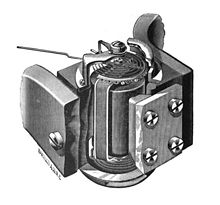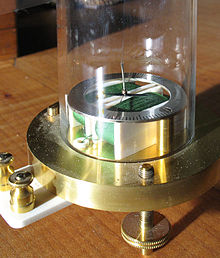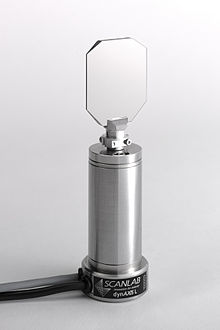- Galvanometer
-
A galvanometer is a type of ammeter: an instrument for detecting and measuring electric current. It is an analog electromechanical transducer that produces a rotary deflection of some type of pointer in response to electric current flowing through its coil in a magnetic field. The term has expanded to include uses of the same mechanism in recording, positioning, and servomechanism equipment.
Contents
History
The deflection of a magnetic compass needle by current in a wire was first described by Hans Oersted in 1820. The phenomenon was studied both for its own sake and as a means of measuring electrical current. The earliest galvanometer was reported by Johann Schweigger at the University of Halle on 16 September 1820. André-Marie Ampère also contributed to its development. Early designs increased the effect of the magnetic field due to the current by using multiple turns of wire; the instruments were at first called "multipliers" due to this common design feature. The term "galvanometer", in common use by 1836, was derived from the surname of Italian electricity researcher Luigi Galvani, who discovered in 1771 that electric current could make a frog's leg jerk.
Originally the instruments relied on the Earth's magnetic field to provide the restoring force for the compass needle; these were called "tangent" galvanometers and had to be oriented before use. Later instruments of the "astatic" type used opposing magnets to become independent of the Earth's field and would operate in any orientation. The most sensitive form, the Thompson or mirror galvanometer, was invented by William Thomson (Lord Kelvin) and patented by him in 1858. Instead of a compass needle, it used tiny magnets attached to a small lightweight mirror, suspended by a thread; the deflection of a beam of light greatly magnified the deflection due to small currents. Alternatively the deflection of the suspended magnets could be observed directly through a microscope.
The ability to quantitatively measure voltage and current allowed Georg Ohm to formulate Ohm's Law, which states that the voltage across a conductor is directly proportional to the current through it.
The early moving-magnet form of galvanometer had the disadvantage that it was affected by any magnets or iron masses near it, and its deflection was not linearly proportional to the current. In 1882 Jacques-Arsène d'Arsonval and Marcel Deprez developed a form with a stationary permanent magnet and a moving coil of wire, suspended by fine wires which provided both an electrical connection to the coil and the restoring torque to return to the zero position. An iron tube within the coil concentrated the magnetic field. A mirror attached to the coil deflected a beam of light to indicate the coil position. The concentrated magnetic field and delicate suspension made these instruments sensitive; d'Arsonval's initial instrument could detect ten microamperes.[1] Edward Weston extensively improved the design. He replaced the fine wire suspension with a pivot, and provided restoring torque and electrical connections through spiral springs rather like those in a wristwatch balance wheel. He developed a method of stabilizing the magnetic field of the permanent magnet, so that the instrument would have consistent accuracy over time. He replaced the light beam and mirror with a knife-edge pointer, which could be directly read; a mirror under the pointer and in the same plane as the scale eliminated parallax error in observation. To maintain the field strength, Weston's design used a very narrow slot in which the coil was mounted, with a minimal air-gap and soft iron pole pieces; this made the deflection of the instrument more linear with respect to coil current. Finally, the coil was wound on a light former made of conductive metal, which acted as a damper. By 1888 Edward Weston had patented and brought out a commercial form of this instrument, which became a standard component in electrical equipment. It was known as the "portable" instrument because it was little affected by mounting position or by transporting it from place to place. This design is almost universally used in moving-coil meters today.
Operation
 D'Arsonval/Weston galvanometer movement. Part of the magnet's left pole piece is broken out to show the coil
D'Arsonval/Weston galvanometer movement. Part of the magnet's left pole piece is broken out to show the coil
The most familiar use is as an analog measuring instrument, often called a meter. It is used to measure the direct current (flow of electric charge) through an electric circuit. The D'Arsonval/Weston form used today is constructed with a small pivoting coil of wire in the field of a permanent magnet. The coil is attached to a thin pointer that traverses a calibrated scale. A tiny torsion spring pulls the coil and pointer to the zero position.
When a direct current (DC) flows through the coil, the coil generates a magnetic field. This field acts against the permanent magnet. The coil twists, pushing against the spring, and moves the pointer. The hand points at a scale indicating the electric current. Careful design of the pole pieces ensures that the magnetic field is uniform, so that the angular deflection of the pointer is proportional to the current. A useful meter generally contains provision for damping the mechanical resonance of the moving coil and pointer, so that the pointer settles quickly to its position without oscillation.
The basic sensitivity of a meter might be, for instance, 100 microamperes full scale (with a voltage drop of, say, 50 millivolts at full current). Such meters are often calibrated to read some other quantity that can be converted to a current of that magnitude. The use of current dividers, often called shunts, allows a meter to be calibrated to measure larger currents. A meter can be calibrated as a DC voltmeter if the resistance of the coil is known by calculating the voltage required to generate a full scale current. A meter can be configured to read other voltages by putting it in a voltage divider circuit. This is generally done by placing a resistor in series with the meter coil. A meter can be used to read resistance by placing it in series with a known voltage (a battery) and an adjustable resistor. In a preparatory step, the circuit is completed and the resistor adjusted to produce full scale deflection. When an unknown resistor is placed in series in the circuit the current will be less than full scale and an appropriately calibrated scale can display the value of the previously-unknown resistor.
Because the pointer of the meter is usually a small distance above the scale of the meter, parallax error can occur when the operator attempts to read the scale line that "lines up" with the pointer. To counter this, some meters include a mirror along the markings of the principal scale. The accuracy of the reading from a mirrored scale is improved by positioning one's head while reading the scale so that the pointer and the reflection of the pointer are aligned; at this point, the operator's eye must be directly above the pointer and any parallax error has been minimized.
Types
Extremely sensitive measuring equipment once used mirror galvanometers that substituted a mirror for the pointer. A beam of light reflected from the mirror acted as a long, massless pointer. Such instruments were used as receivers for early trans-Atlantic telegraph systems, for instance. The moving beam of light could also be used to make a record on a moving photographic film, producing a graph of current versus time, in a device called an oscillograph.
Today the main type of galvanometer mechanism still used is the moving coil D'Arsonval/Weston mechanism, which is used in traditional analog meters.
Tangent galvanometer
A tangent galvanometer is an early measuring instrument used for the measurement of electric current. It works by using a compass needle to compare a magnetic field generated by the unknown current to the magnetic field of the Earth. It gets its name from its operating principle, the tangent law of magnetism, which states that the tangent of the angle a compass needle makes is proportional to the ratio of the strengths of the two perpendicular magnetic fields. It was first described by Claude Pouillet in 1837.
A tangent galvanometer consists of a coil of insulated copper wire wound on a circular non-magnetic frame. The frame is mounted vertically on a horizontal base provided with levelling screws. The coil can be rotated on a vertical axis passing through its centre. A compass box is mounted horizontally at the centre of a circular scale. It consists of a tiny, powerful magnetic needle pivoted at the centre of the coil. The magnetic needle is free to rotate in the horizontal plane. The circular scale is divided into four quadrants. Each quadrant is graduated from 0° to 90°. A long thin aluminium pointer is attached to the needle at its centre and at right angle to it. To avoid errors due to parallax a plane mirror is mounted below the compass needle.
In operation, the instrument is first rotated until the magnetic field of the Earth, indicated by the compass needle, is parallel with the plane of the coil. Then the unknown current is applied to the coil. This creates a second magnetic field on the axis of the coil, perpendicular to the Earth's magnetic field. The compass needle responds to the vector sum of the two fields, and deflects to an angle equal to the tangent of the ratio of the two fields. From the angle read from the compass's scale, the current could be found from a table.[2]
The current supply wires have to be wound in a small helix, like a pig's tail, otherwise the field due to the wire will affect the compass needle and an incorrect reading will be obtained.
Theory
The galvanometer is oriented so that the plane of the coil is parallel to the local magnetic meridian, that is the horizontal component BH of the Earth's magnetic field. When a current passes through the galvanometer coil, a second magnetic field B perpendicular to the coil is created, of strength:
where I is the current in amperes, n is the number of turns of the coil and r is the radius of the coil. These two perpendicular magnetic fields add vectorially, and the compass needle points along the direction of their resultant, at an angle of:
From tangent law,
 , i.e.
, i.e.or
or
 , where K is called the Reduction Factor of the tangent galvanometer.
, where K is called the Reduction Factor of the tangent galvanometer.One problem with the tangent galvanometer is that its resolution degrades at both high currents and low currents. The maximum resolution is obtained when the value of θ is 45°. When the value of θ is close to 0° or 90°, a large percentage change in the current will only move the needle a few degrees.
Geomagnetic field measurement
A tangent galvanometer can also be used to measure the magnitude of the horizontal component of the geomagnetic field. When used in this way, a low-voltage power source, such as a battery, is connected in series with a rheostat, the galvanometer, and an ammeter. The galvanometer is first aligned so that the coil is parallel to the geomagnetic field, whose direction is indicated by the compass when there is no current through the coils. The battery is then connected and the rheostat is adjusted until the compass needle deflects 45 degrees from the geomagnetic field, indicating that the magnitude of the magnetic field at the center of the coil is the same as that of the horizontal component of the geomagnetic field. This field strength can be calculated from the current as measured by the ammeter, the number of turns of the coil, and the radius of the coils.
Astatic galvanometer
The astatic galvanometer was developed by Leopoldo Nobili in 1825.[3]
Unlike a compass-needle galvanometer, the astatic galvanometer has two magnetic needles parallel to each other, but with the magnetic poles reversed. The needle assembly is suspended by a silk thread, and has no net magnetic dipole moment. It is not affected by the earth's magnetic field. The lower needle is inside the current sensing coils and is deflected by the magnetic field created by the passing current.
Uses
An automatic exposure unit from an 8 mm movie camera, based on a galvanometer mechanism (center) and a CdS photoresistor in the opening at left.
Past uses
A major early use for galvanometers was for finding faults in telecommunications cables. They were superseded in this application late in the 20th century by time-domain reflectometers.
Probably the largest use of galvanometers was the D'Arsonval/Weston type movement used in analog meters in electronic equipment. Since the 1980s, galvanometer-type analog meter movements have been displaced by analog to digital converters (ADCs) for some uses. A digital panel meter (DPM) contains an analog to digital converter and numeric display. The advantages of a digital instrument are higher precision and accuracy, but factors such as power consumption or cost may still favor application of analog meter movements.
Galvanometer mechanisms were also used to position the pens in analog strip chart recorders such as used in electrocardiographs, electroencephalographs and polygraphs. Strip chart recorders with galvanometer driven pens may have a full scale frequency response of 100 Hz and several centimeters deflection. The writing mechanism may be a heated tip on the needle writing on heat-sensitive paper, or a hollow ink-fed pen. In some types the pen is continuously pressed against the paper, so the galvanometer must be strong enough to move the pen against the friction of the paper. In other types, such as the Rustrak recorders, the needle is only intermittently pressed against the writing medium; at that moment, an impression is made and then the pressure is removed, allowing the needle to move to a new position and the cycle repeats. In this case, the galvanometer need not be especially strong.
Galvanometer mechanisms were also used in exposure mechanisms in film cameras.
Modern uses
Most modern uses for the galvanometer mechanism are in positioning and control systems. Galvanometer mechanisms are divided into moving magnet and moving coil galvanometers; in addition, they are divided into closed-loop and open-loop - or resonant - types.
Mirror galvanometer systems are used as beam positioning or beam steering elements in laser scanning systems. For example, for material processing with high-power lasers, mirror galvanometer are typically high power galvanometer mechanisms used with closed loop servo control systems. The newest galvanometers designed for beam steering applications can have frequency responses over 10 kHz with appropriate servo technology. Examples of manufacturers of such systems are Cambridge Technology Inc. (www.camtech.com) - now part of General Scanning (www.gsig.com) - and Scanlab (www.scanlab.de). Closed-loop mirror galvanometers are also used in stereolithography, in laser sintering, in laser engraving, in laser beam welding, in laser TV, in laser displays, and in imaging applications such as Optical Coherence Tomography (OCT) retinal scanning. Almost all of these galvanometers are of the moving magnet type.
Open loop, or resonant mirror galvanometers, are mainly used in laser-based barcode scanners, in some printing machines, in some imaging applications, in military applications, and in space systems. Their fat-free bearings are especially of interest in all applications that require a vacuum.
A galvanometer mechanism is used for the head positioning servos in hard disk drives. These are all of the moving coil type, in order to keep mass, and thus access times, as low as possible.
Galvanometer mechanisms are also used for the head positioning in CD/DVD players. Especially in automotive versions, these mechanisms allow a better stability against external vibrations.
The e-meter, a device used by Scientologists during Auditing, is a modified variant of the galvanometer.
See also
- String galvanometer
- Mirror galvanometer
- Vibration galvanometer
- Ballistic galvanometer
- Astatic galvanometer
- Thermo galvanometer
References
- ^ Joseph F. Keithley The story of electrical and magnetic measurements: from 500 B.C. to the 1940s, John Wiley and Sons, 1999 ISBN 0780311930, pp. 196-198
- ^ Tangent Galvanometer
- ^ Greenslade, Thomas. "Instruments for Natural Philosophy — Astatic Galvanometer". http://physics.kenyon.edu/EarlyApparatus/Electrical_Measurements/Astatic_Galvanometer/Astatic_Galvanometer.html. Retrieved 2010-12-19.
External links
- Galvanometer - Interactive Java Tutorial National High Magnetic Field Laboratory
- Selection of historic galvanometer in the Virtual Laboratory of the Max Planck Institute for the History of Science
Categories:- Electronic test equipment
- Historical scientific instruments
Wikimedia Foundation. 2010.










